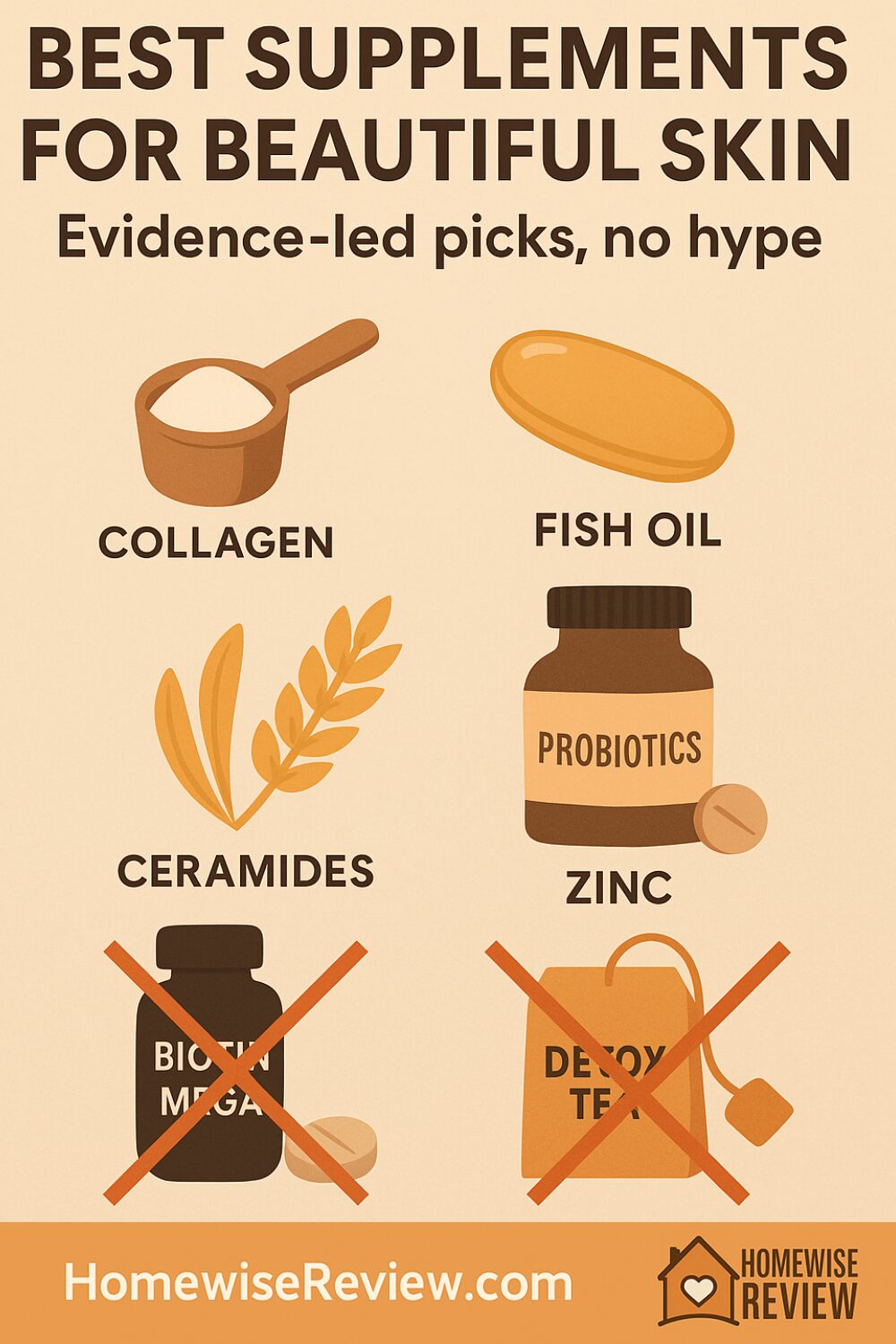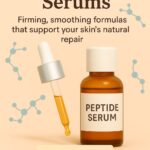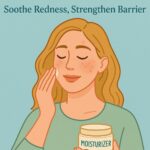
Looking for a skin upgrade in a bottle It is hard to tell what is real and what is just clever marketing. Most “beauty” supplements are either underdosed, wrapped in buzzwords, or promise results they cannot deliver. This guide keeps it honest. We highlight the few categories with decent human data and clear dosing, and we call out the overhyped products that are not worth your money.
A quick reality check. Sleep, stress control, protein, and daily SPF do more for skin than any capsule. Supplements are helpers, not magic. The picks below focus on evidence, safety, and quality testing, with simple guidance on who they suit, how long they take, and when to skip them. If you have a medical condition, are pregnant, or take medication, talk to your clinician before starting anything new.
Food, sleep, stress control and daily SPF do more for skin than any capsule. Supplements can help when you pick the right ones and use them consistently, but they won’t out-perform cleanser, moisturiser and sunscreen.
Quick picks (evidence-led)
- Collagen peptides (Type I/III, hydrolysed) — modest but real improvements in elasticity, hydration and fine lines after 8–12 weeks at 2.5–10 g/day. Look for bovine or marine collagen, hydrolysed, with vitamin C optional.
Rating: 4.5/5 - Omega-3 fish oil (EPA/DHA) — supports barrier function and calms inflammatory skin conditions for some people; choose triglyceride-form fish oil with ~1 g combined EPA/DHA/day.
Rating: 4.3/5 - Ceramides (plant-derived “wheat extract oil” / glucosylceramides) — small but consistent studies show improved hydration and TEWL at ~40–80 mg/day after 4–8 weeks.
Rating: 4.1/5 - Zinc (for acne-prone skin, short term) — may reduce inflammatory spots in those low in zinc; aim for 15–30 mg elemental zinc/day (e.g., zinc picolinate) for 8–12 weeks, then reassess.
Rating: 3.9/5 - Targeted probiotics (modest help) — certain strains (e.g., Lactobacillus rhamnosus, Bifidobacterium lactis) show small benefits for acne or atopic dermatitis. Look for strain-named products, not generic “probiotic”.
Rating: 3.7/5
Disclosure: This guide may contain affiliate links. If you buy through our links, we may earn a small commission at no cost to you. This is not medical advice.
What’s overhyped (save your money)
- Biotin megadoses — unless you’re deficient (rare), biotin doesn’t “transform” skin and can skew lab tests (thyroid, troponin). Most hair/skin/nail gummies are expensive sweets.
- Mega-antioxidants (A, E, selenium) — high doses can be harmful and don’t beat a balanced diet.
- Oral hyaluronic acid — thin evidence; spend on a good moisturiser or serum instead.
- “Proprietary blend” beauty powders — vague dosing, pretty packaging, little data.
- Detox teas/cleanses — diuretics and laxatives. Not skin care.
Deep dives
1) Collagen peptides (hydrolysed Type I/III)
Why it works: Small peptides are absorbed and may signal fibroblasts to make collagen/elastin; multiple RCTs show improved elasticity and hydration and reduced fine lines after 8–12 weeks.
Dose: 2.5–10 g/day, marine or bovine is fine. Take with or without food; vitamin C can help collagen synthesis.
Best for: Fine lines, dryness, post-sun dullness.
Watch outs: Fish allergy for marine collagen; not vegan.
Pros: Real-world, noticeable “plumper” feel for many users; easy to mix.
Cons: Not a facelift. Needs daily use for months.
Rating: 4.5/5
2) Omega-3 fish oil (EPA/DHA)
Why it works: Anti-inflammatory, may improve barrier lipids and reduce redness/itch. Helpful adjunct for acne, dermatitis, psoriasis in some.
Dose: Aim for ~1,000 mg EPA+DHA/day (check label).
Choose: Triglyceride-form, IFOS/NSF-tested, low TOTOX.
Best for: Redness-prone, inflammatory skin; very dry winter skin.
Watch outs: Fish allergy; can interact with blood thinners.
Pros: Whole-body benefit; barrier support.
Cons: Fishy burps if quality is poor; not a spot treatment.
Rating: 4.3/5
3) Ceramides (glucosylceramides)
Why it works: Oral plant ceramides have shown better hydration and reduced TEWL in small trials—think “internal moisturiser”.
Dose: ~40–80 mg glucosylceramides/day for 4–8 weeks.
Best for: Tight, flaky, dry/sensitive skin; winter routines.
Watch outs: Some are wheat-derived—check for gluten if coeliac.
Pros: Subtle, steady comfort boost; stacks well with topical ceramide creams.
Cons: Gentle effect; choose verified dose.
Rating: 4.1/5
4) Zinc (acne-adjunct, short term)
Why it works: Supports immune balance and oil gland activity; helps inflammatory acne if you’re low.
Dose: 15–30 mg elemental zinc/day (picolinate or gluconate) for 8–12 weeks, then review.
Best for: Teen/adult acne with red, inflamed lesions.
Watch outs: Nausea on an empty stomach, copper depletion long term; avoid megadoses.
Pros: Cheap; can be effective for the right user.
Cons: Not for indefinite use; won’t fix hormonal cystic acne alone.
Rating: 3.9/5
5) Probiotics (strain-specific)
Why it works: Gut-skin axis; certain named strains show small improvements in acne severity or eczema itch.
Dose: Follow label; look for strains such as L. rhamnosus GG, L. paracasei, B. lactis.
Best for: Mild acne, atopic dermatitis support, frequent antibiotic courses.
Watch outs: Immunocompromised—speak to your clinician first.
Pros: Gentle adjunct; GI benefits too.
Cons: Results vary by strain and dose; generic blends are hit-and-miss.
Rating: 3.7/5
Quality checklist (don’t skip this)
- Third-party testing: NSF, USP, Informed Choice, IFOS (for fish oil).
- Clear dosing: avoid “proprietary blends”.
- Full ingredient list: allergens, fillers, capsule materials.
- Sensible doses: no megadoses of vitamins A/E/selenium.
- Safety: pregnancy/breastfeeding, meds (anticoagulants, isotretinoin), allergies.
How to stack supplements with skincare (the smart way)
- Build the basics first: gentle cleanser, daily SPF, moisturiser that fits your skin type.
- Choose one supplement to start, not five. Track for 12 weeks.
- Photograph progress monthly under the same lighting.
- Keep actives simple: retinoid 2–4 nights/week, niacinamide or azelaic acid if you’re acne-prone or red.
- Re-evaluate seasonally. If nothing changes after 12 weeks, stop and try a different category.
See also
If your skin is dry or tight, start with Skin Routine for Dry Skin and a calming step from Skin Serums for Sensitive Skin. For texture and early lines, pair collagen with a smart topical routine in Best Moisturizer for Mature Skin.
Dealing with breakouts Check Best Facial Washes for Acne-Prone Skin and Best Moisturizer for Acne-Prone Skin for light hydrators that won’t clog. If under-eyes are a recurring gripe, Makeup for Dark Circles has application tricks that actually help.
FAQs
How long until I see results
Most skin-relevant supplements need 8–12 weeks of daily use. Collagen and ceramides show earlier hydration/elasticity wins; acne-related zinc may help by 6–8 weeks.
Can I take collagen if I’m pescatarian
Yes—choose marine collagen (check fish allergy). Vegans can’t take true collagen; prioritise protein, vitamin C and topical retinoids/peptides.
Do gummies work
f the dose is right, yes—but they’re usually more expensive and high in sugar. Powders/capsules are better value.
Is there a “skin multivitamin”
No single pill beats a balanced diet. If you suspect deficiency (iron, B12, vitamin D), get a blood test and supplement under guidance.
Can I take all of these together
Often yes, but keep dosages sensible and check interactions (e.g., fish oil + anticoagulants; zinc long-term depletes copper).




